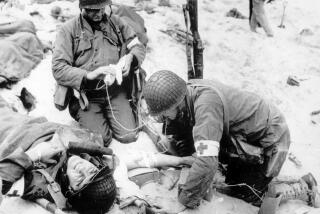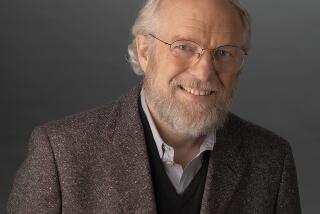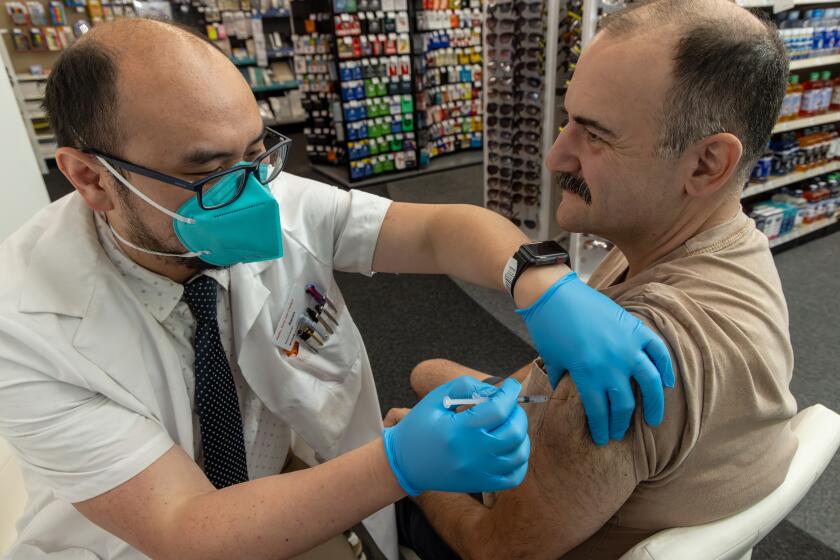Dr. Robert M. Chanock dies at 86; virologist broke ground in respiratory virus research
- Share via
Dr. Robert M. Chanock, a virologist who made a remarkable series of discoveries about respiratory viruses in the 1960s and 1970s, including the isolation of the deadly respiratory syncytial virus and four para- influenza viruses, died Aug. 4 at a residential care center in Sykesville, Md. He was 86 and had Alzheimer’s disease.
Chanock also identified the cause of what was once called walking pneumonia, developed an adenovirus vaccine that is widely used by the military, laid the foundation for the discovery of hepatitis A and C and the development of vaccines against them, pioneered the development of the nasal spray influenza vaccine and played a key role in the discovery of the Norwalk virus, the first member of the family of viruses that cause what is generally known as intestinal flu.
One of his biggest disappointments was his team’s inability to develop a vaccine against the respiratory syncytial virus, but they did develop antibodies that could be used to protect infants at high risk for the disease.
Dorland Davis, a former head of what is now the Laboratory of Infectious Diseases at the National Institutes of Health, wrote of Chanock that “never in the history of infectious disease research has one person developed so much definitive information about the causes of so much human disease in so short a period of time.”
Dr. Albert Sabin, the developer of the oral polio vaccine and a mentor of Chanock who died in 1993, called him “my star scientific son.”
Respiratory syncytial virus, commonly known as RSV, is one of the most common infectious agents in the world, infecting almost all infants before the age of 1. In the United States, outbreaks begin in the fall and end in the spring, with as many as 125,000 infants under the age of 1 hospitalized each year. Worldwide, at least 200,000 infants die of it each year.
In 1957, Chanock and his colleagues isolated the RSV virus, which proved to be unusually difficult to grow in the laboratory. The team originally produced an RSV vaccine by inactivating the virus with formalin, a technique that had been successfully used with influenza viruses. But because of peculiar interactions between the virus and the human immune system, that vaccine not only did not protect against infection, but also made symptoms worse when infection did occur.
The group eventually developed a mutated virus that is used in a live-virus RSV vaccine now undergoing clinical trials.
Chanock also attacked a form of atypical pneumonia that was called walking pneumonia because, even though the lungs were filled with secretions, a person could still move about. Most researchers were confident that it was caused by a hard-to-find virus, but he showed that it was actually caused by a bacterium that he identified and named Mycoplasma pneumoniae. He demonstrated that the infection responded to therapy with the antibiotic tetracycline.
Adenoviruses are a form of cold virus and two, in particular, were causing severe outbreaks among soldiers in crowded barracks. Chanock discovered that the viruses were effectively harmless when they triggered an infection in the intestines; it was only when they entered through the lungs that they caused problems.
He developed an oral vaccine in which the viruses were coated so that they entered only the intestines, where they did no harm but provoked immunity to infection. The vaccines are now widely used by the military, but the approach did not prove effective for other types of infections.
He also identified four para-influenza viruses that are the most common cause of severe croup in infants and important causes of other respiratory diseases.
In the early 1970s, Chanock and his colleagues showed that a massive outbreak of nonbacterial diarrhea in Norwalk, Conn., was caused by a virus that they successfully transmitted to human volunteers. Chanock’s associate, Dr. Albert Kapikian, used the new technique of immune electron microscopy to identify the virus, which came to be known as the Norwalk virus.
The team eventually identified a series of related viruses, called noroviruses, that are now thought to account for the bulk of gastroenteritis, or intestinal flu, in the United States.
Robert Merritt Chanock was born July 6, 1924, in Chicago. In high school, he wanted to be a physicist. But when he was drafted during World War II, he was given the choice of going to the European front or attending medical school, and chose the latter, enrolling at the University of Chicago. He received his bachelor’s degree in 1945 and his medical degree two years later. After graduating, he specialized in pediatrics.
He was drafted again in 1952 for the Korean War and was on his way to that country to study a virus that caused encephalitis in troops when his appendix ruptured. As a result, he did infectious disease research in Tokyo, setting the stage for his entire career.
After the war, he worked with Sabin at Children’s Hospital in Cincinnati and at Johns Hopkins University in Baltimore before joining what is now the National Institute of Allergy and Infectious Diseases in 1957.
He retired in 2002, but continued working until 2008, when his illness forced him to stop.
Chanock’s wife of 60 years, the former Catherine Osgood, died in 2009. A son, Foster, died in 1980. He is survived by one son, Stephen of Potomac, Md., and four grandchildren.
thomas.maugh@latimes.com






